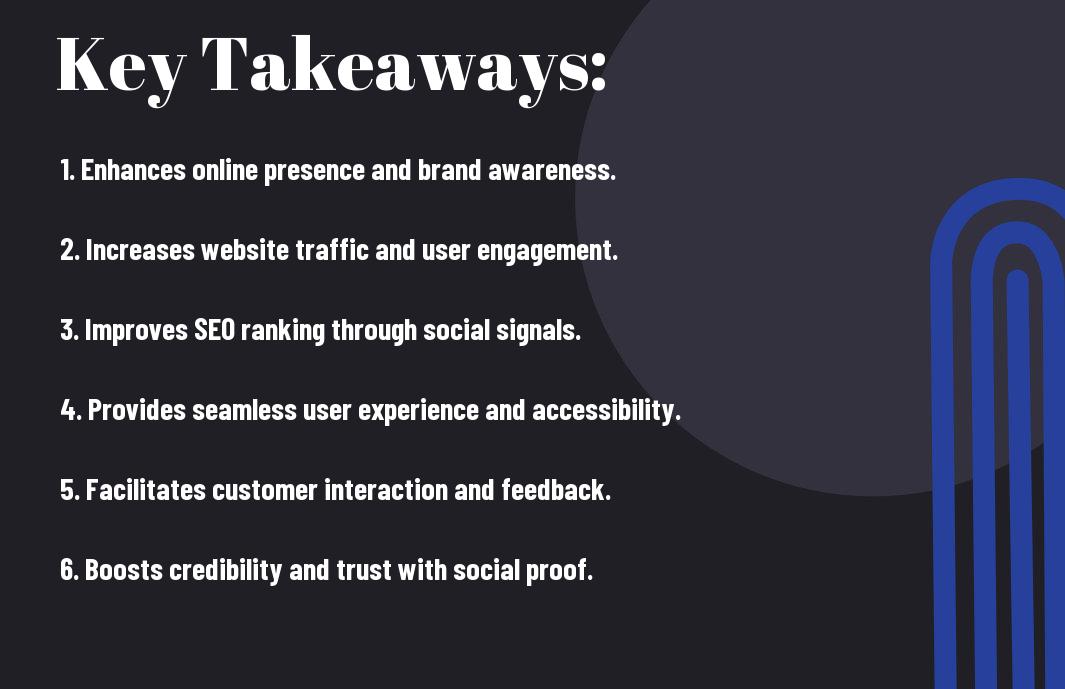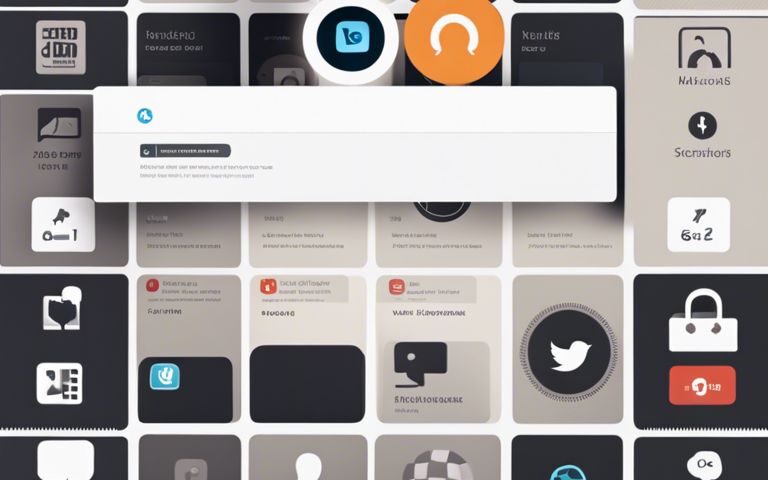The Importance Of Social Media Integration In Modern Website Design

The Importance Of Social Media Integration In Modern Website Design
March 26, 2024
The Importance Of Social Media Integration In Modern Website Design
March 28, 2024With social media becoming an integral part of our daily lives, its impact on website design cannot be understated. In today’s digital age, a strong online presence is crucial for businesses to thrive, and social media integration plays a key role in achieving this. Incorporating social sharing buttons, live feeds, and engagement widgets into website design can significantly enhance user experience and broaden the reach of the website. Furthermore, social media integration boosts brand visibility and credibility while also improving SEO rankings. Ignoring the power of social media in website design can result in missed opportunities for customer engagement and growth. Stay ahead of the curve by understanding the importance of social media integration in modern website design.
Key Takeaways:
- Social media integration is vital for modern website design to engage with audiences and drive traffic.
- Integrating social media enables easy sharing of website content, thereby expanding reach and visibility.
- Social media buttons on websites encourage user interaction and boost brand credibility and trust.

Understanding Social Media Integration
Definition and Scope
One of the key components of modern website design is the integration of social media platforms. This involves incorporating social media functionalities and features into a website to enhance user engagement, expand reach, and improve brand visibility. Social media integration allows website visitors to interact with the website through their social media accounts, sharing content easily and increasing overall online presence.
Key Benefits for Websites
Websites that fully embrace social media integration experience a myriad of benefits. Firstly, it allows for increased brand awareness as content is shared across various social media platforms, reaching a wider audience. Secondly, social media integration boosts user engagement by making it easier for visitors to interact with and share website content. Lastly, it can positively impact a website’s SEO by driving more traffic and improving search engine rankings.
Implementing Social Media Features in Web Design
Social Sharing Buttons
Buttons Now play a crucial role in driving traffic to your website through social media platforms. By integrating social sharing buttons on your website, you empower users to easily share your content with their friends and followers, increasing your visibility and reach. These buttons make it effortless for visitors to promote your content across various social media channels such as Facebook, Twitter, and Instagram.
Social Login Capabilities
The implementation of social login capabilities The on your website can streamline the user experience and make it more convenient for visitors to sign in to your platform. By allowing users to log in using their social media accounts such as Facebook or Google, you eliminate the need for them to create a new account, reducing friction and increasing conversion rates. This feature also provides you with valuable user data, allowing you to better understand your audience and deliver more personalized experiences.
Understanding the significance of integrating social sharing buttons and social login capabilities into your website design is crucial in today’s digital landscape. These features not only enhance user engagement but also have the potential to boost your website’s traffic and conversion rates significantly. By embracing social media integration, you can stay ahead of the competition and maximize the impact of your online presence.

Enhancing User Engagement Through Social Media
Leveraging User-Generated Content
Many modern websites are harnessing the power of user-generated content to enhance user engagement. Users are more likely to trust and engage with content created by their peers rather than traditional advertising. By integrating social media platforms on websites, businesses can easily showcase user-generated content such as reviews, testimonials, and social media posts related to their products or services. This not only creates a sense of authenticity but also encourages users to actively participate and contribute to the online community.
Developing Community and Fostering Interaction
Any website looking to enhance user engagement should focus on developing a sense of community among its users. Social media integration allows for seamless interaction between users, fostering discussions, sharing of experiences, and building relationships. By creating a space where users can connect with each other and with the brand, websites can cultivate a loyal following and increase user engagement levels.
An effective way to develop community and foster interaction is by creating dedicated social media groups or forums where users can communicate, ask questions, and share their thoughts. This not only increases user engagement but also provides valuable insights for the business on customer preferences and behaviors. By actively participating in these online communities, businesses can build trust and credibility among their target audience.
Best Practices for Social Media Integration
Strategic Placement and Design Considerations
Despite the significance of social media integration on websites, the strategic placement and design considerations play a crucial role in maximizing its effectiveness. The placement of social media icons, widgets, or feed displays should be strategically positioned to attract user attention without overshadowing the main content of the website.
Maintaining Balance: Usability and Aesthetics
Considerations must be made to maintain a balance between usability and aesthetics when integrating social media elements into website design. The ease of navigation and functionality should not be compromised by the addition of social media features. At the same time, the design should be visually appealing and in harmony with the overall aesthetics of the website.
Balance is key when it comes to integrating social media into website design. Usability and aesthetics should work hand in hand to create a seamless user experience. Striking the right balance ensures that the website not only looks good but also functions effectively, enhancing user engagement and interaction.

Challenges and Considerations
Privacy and Security Implications
To effectively integrate social media into website design, it’s crucial to address privacy and security concerns. Privacy issues arise when users are required to log in through their social media accounts, raising questions about data sharing and user consent. Security risks include potential breaches of personal information or accounts through social plugins and widgets. To mitigate these risks, websites must prioritize data protection and transparency in their social media integration strategies.
Adapting to Changing Social Media Trends
Adapting to evolving social media trends is important for maintaining a dynamic online presence. Keeping up with the latest platforms and features can be challenging but is necessary to engage with audiences effectively. Monitoring emerging trends and adjusting integration strategies accordingly can help websites stay relevant and maximize their reach. To effectively utilize social media, websites must be agile and prepared to evolve with the ever-changing digital landscape.
Implications: Staying informed about privacy regulations and implementing secure data practices is paramount when integrating social media into website design. Adapting to changing social media trends requires continuous monitoring and flexibility to capitalize on new opportunities and reach target audiences effectively.

Conclusion
So, the integration of social media in modern website design plays a pivotal role in enhancing user engagement, expanding reach, and boosting brand visibility. By seamlessly incorporating social media elements into websites, businesses can effectively connect with their target audience, promote their content, and increase overall online presence. To probe deeper into the importance and benefits of social media integration in website design, you can read more at The Role of Social Media Integration in Modern Website Development.
FAQ
Q: Why is social media integration important in modern website design?
A: Social media integration is important in modern website design because it allows businesses to connect with their audience, increase brand visibility, drive traffic to their website, and improve their overall online presence.
Q: How can social media integration benefit a website?
A: Social media integration can benefit a website by increasing user engagement, encouraging social sharing of content, expanding reach to a wider audience, and enhancing search engine optimization (SEO) efforts.
Q: What are some ways to integrate social media into website design?
A: Some ways to integrate social media into website design include adding social media buttons for easy sharing, displaying live social media feeds, embedding social media posts, and incorporating social login options for users.
Q: Does social media integration impact website performance?
A: When done correctly, social media integration should not have a significant impact on website performance. However, it is important to optimize the integration to ensure that it does not slow down page loading times.
Q: How can businesses measure the success of social media integration on their website?
A: Businesses can measure the success of social media integration on their website by tracking metrics such as social media referrals, engagement rates, conversion rates from social media traffic, and overall growth in social media following. Additionally, conducting A/B testing can help to refine social media integration strategies for optimal results.


